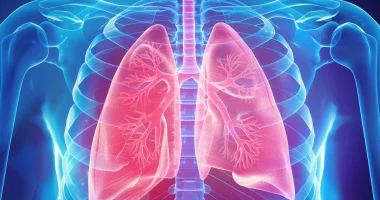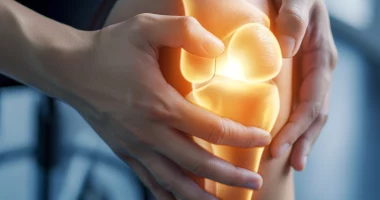Chronic pain
What is chronic pain?
Pain is one of the most common reasons why people seek medical attention. We are talking about chronic pain in the following cases:
- the pain doesn’t go away for longer than 3-6 months;
- pain persists after an injury, even if the injury has already healed.
People perceive pain differently, and social and psychological factors can influence this.
Chronic pain affects all areas and impairs quality of life. People with chronic pain often develop fears, depressed moods, or sleep disturbances. It can adversely affect pain perception and pain signal processing and can make the pain even worse. Therefore, the best treatment is considered in addition to the various medications, the psychological state and social situation of the patient are also taken into account.
How does chronic pain manifest itself?
The manifestations of pain can be very different. Pain in internal organs is usually dull or spastic as if it were deep inside. Patients are often unable to pinpoint exactly where it hurts. Pain in the musculoskeletal system is more often stabbing, pulling, or burning; its location is easier to identify. Pain from nerve damage can be shooting, spastic, tingling, numbness or hypersensitivity.
Older people sometimes have difficulty describing their pain. They often complain about “unpleasant” sensations. People with conditions such as dementia often cannot describe their pain in words. The following signs can then recognize pain:
- a painfully distorted face;
- crying and moaning;
- a protective posture that is gentle on the painful area;
- Intense breathing;
- confusion.
What are the causes of chronic pain?
Chronic pain can be caused by, among other things, a disorder of the nervous system, altered processing of pain signals, or chronic inflammation. Conditions that commonly accompany chronic pain include:
- osteoarthritis;
- back problems;
- rheumatoid arthritis;
- fibromyalgia;
- diabetes.
Different reasons cause different types of pain.
- Nociceptive pain: pain signals come from nociceptors, structures that play an essential role in pain perception. The cause can be, for example, trauma, burns, kidney stones, or myocardial infarction.
- Inflammatory pain: results from tissue inflammation as inflammatory mediators irritate pain receptors. It can be caused by infection or autoimmune disease.
- Neuropathic pain: results from direct nerve damage. It can be caused by nerve damage, nerve root damage, metabolic disorders such as diabetes, cytotoxins such as alcohol, or viral diseases such as shingles.
- Central pain occurs due to changes in the brain’s or spinal cord’s processing of pain signals. The brain produces a pain signal even in the absence of organic damage, as is the case in fibromyalgia, irritable bowel syndrome, or chronic pelvic pain.
Pain can become a disease in its own right. It may persist even though the actual cause is no longer present. In addition, with long-term pain, the nerves become more sensitive and transmit pain signals earlier and faster. New nerve connections can form a painful memory.
In addition, pain may feel faster or worse with prolonged stress. Certain factors may increase the risk of chronic pain. These include:
- hereditary predisposition;
- treatment for acute pain that has not helped sufficiently;
- mental illness, such as depression or post-traumatic stress disorder;
- unfavorable social environment;
- advanced age;
- long-term use of pain medications, especially opioids;
- substance abuse.
How common is chronic pain?
In developed countries, about 3 out of 10 people suffer from moderate to severe pain that lasts for more than six months. More than 40 out of 100 older people complain of chronic pain. The most common complaints are joint and back pain. Chronic pain can occur even in children.
What are the possible consequences of chronic pain?
The quality of life of people with chronic pain is usually limited to some extent. Treatment helps to relieve the pain, but often, it is not eliminated. One medication is usually not enough to reduce pain. For this reason, patients take several different medications, often increasing the dose. As a result, they may experience side effects. For example, paracetamol in high doses can cause severe liver damage. Regular use of powerful painkillers such as opioids can lead to drug dependence. Opioid overdose can also occur with respiratory depression. Sometimes, opioids can also result in a state of hypersensitivity to pain.
How is chronic pain diagnosed?
First of all, it is essential to find the exact cause of the pain. Imaging studies such as X-rays, computed tomography (CT), or magnetic resonance imaging (MRI) are used for this purpose. Certain indicators in blood tests may also indicate the cause. A nerve block is sometimes performed, or nerve conduction is measured for diagnosis. However, even with severe pain, it is not always possible to find the cause.
For treatment, it is essential to determine the pain’s exact location and assess its severity. To do this, the doctor asks the patient questions such as the following.
- When and where did the pain occur?
- How does the pain feel?
- How severe is the pain on a scale of 1 to 10?
- How does pain affect daily activities?
During the physical examination, the physician determines possible limitations in body functions. By asking questions about the patient’s mood, sleep quality, and family or work stress, the physician learns about surrounding circumstances that affect pain perception or may be altered by chronic pain.
How is chronic pain treated?
A multimodal approach should be used to treat chronic pain, i.e., treating it not only medically but also with psychotherapy, physiotherapy, and occupational therapy. Ideally, treatment is provided by a specialist pain therapist. People with chronic pain may also benefit from counseling from specialists in the medical and social field.
Non-medical treatment
- Cognitive-behavioral therapy: this technique is used to find a better way to manage pain and improve nighttime sleep.
- Physical activity and exercise: guided by a physical therapist to improve body function and reduce pain.
- Acupuncture: for local (localized) pain and pain throughout the body.
- Nutritional counseling and weight loss: if obesity plays a role in the onset of pain.
- Assistive devices such as walking aids, splints, or orthopedic shoes.
- Peripheral nerve stimulation: Weak electrical impulses reduce the perception of pain. Little intervention is required for prolonged stimulation.
- Installation of pain pumps: there are special devices that deliver painkillers directly to the spinal cord, which allows you to get rid of chronic pain
Medical treatment
- Topical anesthetic injections or anti-inflammatory, analgesic ointments and gels for localized pain.
- Antidepressants, even in the absence of depression, can affect the perception of pain. The pain may only decrease noticeably after a few weeks, depending on the medication.
- Epilepsy medications (antiepileptic drugs) for pain due to nerve damage.
- Myorelaxants for pain associated with muscle spasms.
- Anti-inflammatory painkillers from the group of non-steroidal anti-inflammatory drugs (NSAIDs), such as ibuprofen or paracetamol, should only be taken if the pain gets worse. It may be worth trying different painkillers as they work differently for different people.
- Strong painkillers, such as opioids or drugs that affect the processing of pain signals in the brain, such as sedatives from the benzodiazepine group, should only be taken for a limited time.
- It is always best to decide on treatment methods together with your doctor. Successful treatment of chronic pain requires patience and a trusting relationship between doctor and patient.
- How do you manage chronic pain in your daily life?
- Chronic pain requires long-term treatment. Often, there is a temporary improvement and then a relapse.
- People with chronic pain need to learn how to manage their discomfort in their daily lives, meaning they need to understand how they can influence and control their pain themselves.
All these treatment options are available in more than 600 hospitals worldwide (https://doctor.global/results/diseases/chronic-pain). For example, Intrathecal pain pump implantation can be done in 21 clinics across Turkey for an approximate price of $2.4 K (https://doctor.global/results/asia/turkey/all-cities/all-specializations/procedures/intrathecal-pain-pump).


